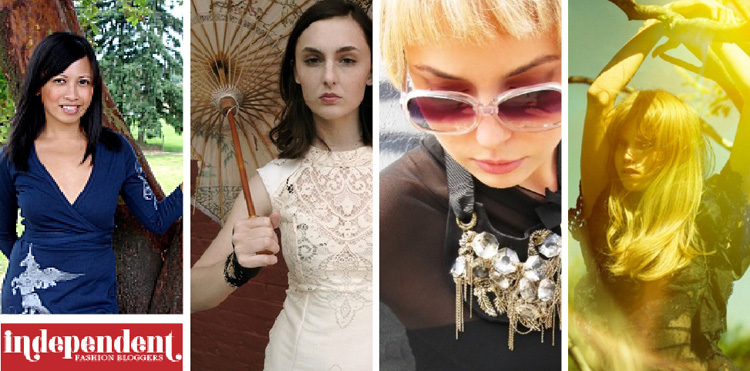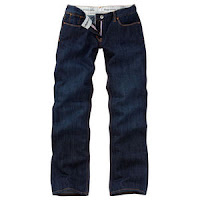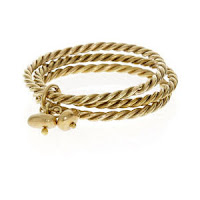Für die deutsche Fassung einfach runterscrollen...
Some posts on other blogs have prompted me to think yet again about a question I have often pondered: how can “green” and “fair trade” labels become more popular. Some people are wondering whether this will always stay a niche market because the marketing budgets of these, usually small enterprises, are so limited. I think that not having a lot of money for advertising isn’t necessarily the problem.
Here are the top 5 obstacles that I think fair trade and organic labels (from here on called FTO) have to overcome:
1) access: FTO labels still aren’t as widely available as “normal” fashion. I like to try on clothes before I buy them but most FTO stuff is only accessible online. FTO labels have to work on being sold in “normal” shops to reach a wider audience.
2) image: If I see ONE more “green” fashion website that uses green, brown and/or beige for their web design I will puke. It’s not only terribly unoriginal but also just plain ugly. Another no-no in my opinion: unprofessional photography and using non-photogenic people to model your clothes. Hopefully they will be worn by the girl next door but don’t ask the girl next door to model for you unless she’s gorgeous. I know that this is a question of money (or perhaps asking everyone you know for help to find the perfect amateur photographer and a great amateur model) but do not save here. You are competing with other labels for the customers who can afford to pay a little more for their clothes so your image and design have to be on par.
3) design: After spending one year of researching FTO clothes I found some wonderful labels with great designs BUT I also found way too many FTO labels with horrible designs. It really is the single most important issue if you want to be successful: your clothes have to look great. Again, maybe you don’t have the money to hire a designer from a high street label but you can get the look for free by poaching. Talent imitates, genius steals. Think of the labels that are sold at the same price point than your clothes and get inspired. It’s really a mystery to me why FTO labels often seem to deliberately shun any trends some of which have already become new classics: gladiators, skinny jeans, oversized tees, plaid shirts, fringed scarves – still hard to find in an FTO version.
4) mixing up fashion and politics: Do you want to be a successful fashion label owner or a successful activist? Don’t get me wrong - you should definitely stress the FTO character of your business. Be as transparent about this as possible. Photograph your studio and the people who make your clothes. Clearly state what makes you an FTO company. Explain why organic is better than standard cotton but don’t get side-tracked by campaigning; selling FTO clothes is already a political statement. And if you aren’t Katharine Hamnett back off from statement t-shirts.
5) trust: A 5$ t-shirt – made in China; a 50$ t-shirt from an FTO label – made in China. You can only get people to pay more if they trust you that there is a difference between these two shirts. If you work together with suppliers my suggestion, again, is to be very transparent about this. Clearly state where the garment was made, who the supplier is and why it’s okay to work with them. If you visit your suppliers take pictures and write about the experience. Be sincere about your efforts to be different than a “normal” high street brand but beware of the holier-than-thou attitude. Do trust your customers that they will prefer the ethical alternative without you having to point the finger at your dirty rivals. Instead, do good and talk about it. Become a member of the World Fair Trade Organisation, the Fairtrade Foundation, the Made-By Initiative or get certified by the FLO (Fairtrade Labelling Organizations International).
***
Neulich habe ich mal wieder darüber nachgedacht, was “grüne” und Fair Trade Modelabel noch erfolgreicher werden könnten. Manche meinen ja, dass dies immer ein Nischenmarkt bleiben wird, u.a. auch deswegen, weil die Marketing Budgets solcher Firmen meistens recht klein sein. Ich denke aber, dass wenig Geld für Werbung nicht unbedingt das Hauptproblem ist.
Hier sind die 5 Hürden, die Fair Trade und grüne Label (ab hier FTG) meiner Meinung nach überwinden müssen:
1) Zugänglichkeit: FTG Marken sind immer noch nicht so einfach erhältlich wie „normale“ Marken. Ich, und viele andere Konsumenten, probieren Kleidung gerne an aber FTG Kleidung ist hauptsächlich online erhältlich. Die FTG Produzenten sollten daran arbeiten, dass ihre Sachen auch in “normalen” Läden verkauft werden, um ein größeres Publikum zu erreichen.
2) Image: Also wenn ich noch eine einzige „grüne“ Modewebseite sehe, die in grün, braun und beige gehalten ist… Das ist nicht nur wahnsinnig unoriginell, sondern außerdem total hässlich. Noch ein Ding der Unmöglichkeit: unprofessionelle Fotografie und nicht-fotogene Modelle. Die Kleidung soll natürlich von jedermann/frau getragen werden, aber für die Kampagne würde ich nie das Mädchen von nebenan fragen, außer sie ist ein Fotomodell. Das ist eine Frage des Geldes (oder aber so lange im Freundeskreis herumzufragen, bis man den/die perfekte/n Amateurfotograf/in und das perfekte Amateurmodell gefunden hat), aber hier sollte auf keinen Fall gespart werden. Die FTG Marken konkurrieren mit andere Marken um die Konsumenten, die es sich leisten können, mehr Geld für Kleidung auszugeben also müssen Image und Design konkurrenzfähig sein.
3) Design: Ich habe mich jetzt ein Jahr lang intensiv damit beschäftigt, was es alles so für FTG Marken gibt und dabei viele tolle Labels mit gutem Design entdeckt aber auch viel zu viele FTG Marken mit grauenhaften Designs. Das allerwichtigste um erfolgreich zu sein: die Klamotten müssen super aussehen. Vielleicht habt ihr nicht genug Geld um eine/n Designer/in von einem erfolgreichen „normalen“ Label abzuwerben, aber den massengeschmackstauglichen Einkaufsstraßenlook kann man ja auch abkupfern. Denkt an die anderen Marken, die zum gleichen Preis wie eure Kleidung verkauft werden und holt euch Inspirationen. Ich verstehe wirklich nicht, warum so viele Trends, von denen einige schon wieder neue Klassiker geworden sind, an den FTG Labels scheinbar spurlos vorbeiziehen: Gladiator-Sandalen, enge Jeans, Oversized T-shirts, Karohemden, Fransenschals – die in einer FTG Version zu finden, ist immer noch schwer.
4) die Vermischung von Mode und Aktivismus: Wollt ihr ein erfolgreiches FTG Label führen oder erfolgreiche Aktivisten sein? Nicht falsch verstehen – natürlich solltet ihr die FTG Ausrichtung eures Geschäftsmodells hervorheben. Seid hier so transparent wie möglich. Fotografiert euer Studio und die Leute, die eure Kleidung herstellen. Erklärt auf verständliche Art und Weise was euch zu einer FTG Firma macht und warum z.B. Biobaumwolle besser als konventionell angebaute ist. Aber verringert die Energie, die ihr in eure Mode stecken solltet, nicht dadurch, dass ihr euch zu sehr auf politische Kampagnen einlasst: FTG Kleidung zu verkaufen ist doch schon ein politisches Statement. Ach ja, und wenn ihr nicht Katharine Hamnett seid lasst lieber die Finger von Statement-Tshirts.
5) Vertrauen: Ein 5 Euro T-shirt – made in China; ein 50 Euro T-shirt von einem FTG Label – made in China. Ich denke, die Leute wählen nur dann das teurere Shirt, wenn sie sich darauf verlassen können, dass es einen Unterschied macht. Wenn ihr mit Lieferanten arbeitet, die eure Kleidung produzieren, solltet ihr sehr offen damit umgehen. Erklärt genau, wo die Kleider gemacht werden, wer der Lieferant ist und warum es okay ist, mit dieser Firma zu arbeiten. Falls ihr eure Lieferanten besuchen solltet, macht Fotos und schreibt über eure Erfahrungen. Vertraut euren Kunden, dass sie die ethisch korrekte Alternative wählen werden, ohne dass ihr mit dem Finger auf die „schmutzigen“ Konkurrenten zeigen müsst. Macht es lieber besser und redet dann darüber. Werdet Mitglieder der World Fair Trade Organisation, der Fairtrade Foundation, der Made-By Initiative oder lasst euch von der FLO (Fairtrade Labelling Organizations International) zertifizieren.


















































